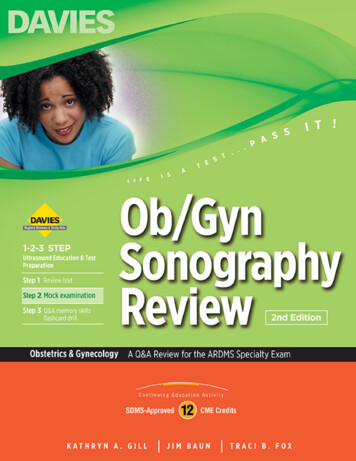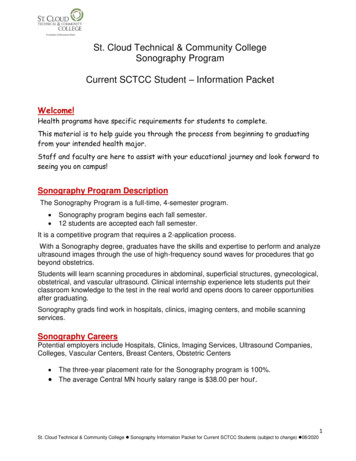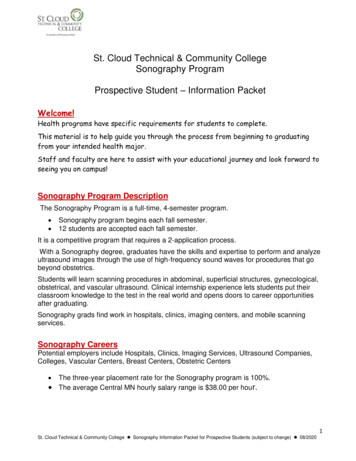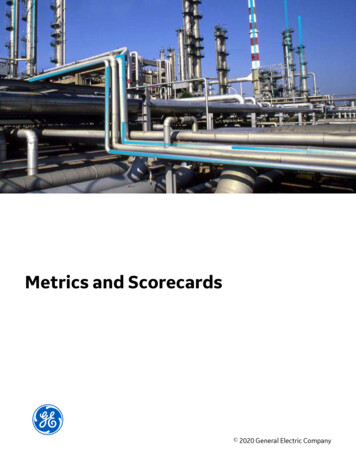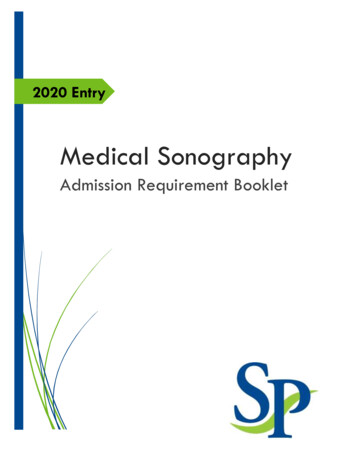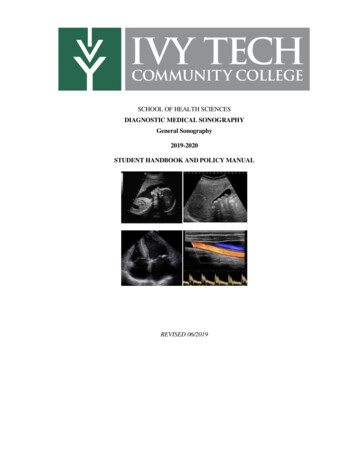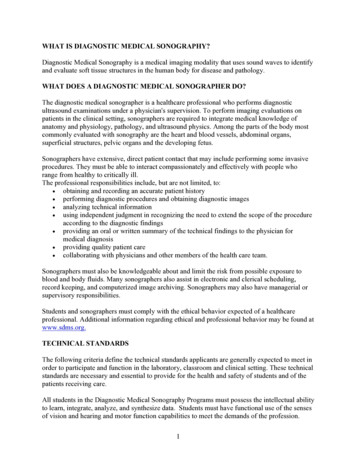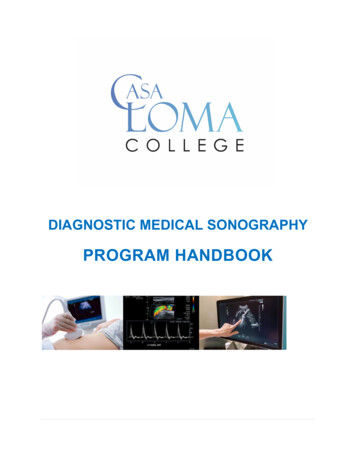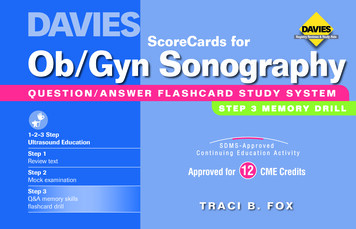
Transcription
ScoreCards forOb/Gyn SonographyQUESTION/ANSWER FLASHCARD STUDY SYSTEMSTEP 3 MEMORY DRILL1-2-3 StepUltrasound EducationStep 1Review textStep 2Mock examinationStep 3Q&A memory skillsflashcard drillSDMS-ApprovedContinuing Education ActivityApproved for12CME CreditsTRACI B. FOX
TMScoreCards forOb/Gyn SonographyA Q&A Flashcard Study System forOb/Gyn SonographyTraci B. Fox, EdD, RT(R), RDMS, RVTJefferson College of Health ProfessionsThomas Jefferson University
Library of Congress Cataloging-in-Publication DataNames: Fox, Traci B., author.Title: ScoreCards for OB/Gyn sonography : a Q&A flashcard study system forOB/Gyn sonography / by Traci B. Fox.Description: Pasadena, California : Davies Publishing, Inc., [2016] Includes bibliographical references and index.Identifiers: LCCN 2016008159 ISBN 9780941022880 (alk. paper)Subjects: MESH: Pregnancy Complications--ultrasonography FemaleUrogenital Diseases--ultrasonography Pelvis--ultrasonography Examination QuestionsClassification: LCC RG107.5.U4 NLM WQ 18.2 DDC 618/.047543--dc23 LCrecord available at http://lccn.loc.gov/2016008159Copyright 2017 by Davies Publishing, Inc. All rights reserved. No part of this work maybe reproduced, stored in a retrieval system, or transmitted in any form or by any means,electronic or mechanical, including photocopying, scanning, and recording, without priorwritten permission from the publisher.Davies Publishing, Inc.32 South Raymond AvenuePasadena, California 91105-1961Website: DaviesPublishing.com/telephone 626-792-3046Cover and text design by Satori Design Group, Inc.Printed in China.ISBN 978-0-941022-88-0
iiiCONTENTSHow to Use ScoreCards v1OBSTETRICS 1First Trimester 1Gestational sac, yolk sac, embryo, ovaries, cul-desac, pregnancy failure, ectopic pregnancySecond and Third Trimesters 79Cranium, spine, heart, thorax, abdomen,extremities, fetal positionPlacenta 169Development, position, anatomy, membranes,umbilical cord, abruption, previa, masses andlesions, maturity and grading, Doppler flow studies,physiology, adherence (accreta, increta, percreta)Assessment of Gestational Age 241Gestational sac, embryonic size/crown-rumplength, biparietal diameter, femur length, abdominalcircumference, head circumference, transcerebellarmeasurements, binocular measurements, cephalicindicesComplications 281Intrauterine growth restriction, multiple gestations,maternal illness, antepartum complications, fetaltherapy, postpartum complicationsAmniotic Fluid 355Assessment, polyhydramnios, oligohydramnios,fetal pulmonic maturity studiesGenetic Studies 371Maternal serum testing, amniotic fluid testing,chorionic villus sampling, dominant/recessive riskoccurrenceFetal Demise 391Fetal Abnormalities 397Cranial, facial, neck, neural tube, abdominal wall,thoracic, genitourinary, gastrointestinal, skeletal,cardiac, syndromesCoexisting Disorders 621Leiomyomas, cystic disorders, trophoblasticdisease, solid/mixed masses, myometrialcontraction
ivContents2 GYNECOLOGY651Normal Pelvic Anatomy 651Uterus, ovaries, fallopian tubes, supportingstructures, cul-de-sacs, vasculature, Doppler flowstudies, gynecology-related studiesPhysiology 721Menstrual cycle, pregnancy tests, human chorionicgonadotropin, fertilizationPediatric 755Precocious puberty, hematometra/hematocolpos,sexual ambiguityInfertility and Endocrinology 777Contraception, causes, medications and treatment,ovulation induction (follicular monitoring), assistedreproductive technology (GIFT, IVF, ZIFT)Postmenopausal 801Anatomy, physiology, therapy, pathologyPelvic Pathology 825Congenital uterine malformation, uterine masses,ovarian masses, endometriosis, polycystic ovariandisease, inflammatory disease, Doppler flowstudies, gynecology-related studiesExtrapelvic Pathology 899Ascites, liver metastasis, hydronephrosis3 PATIENT CARE, SCANNINGTECHNIQUE, AND PHYSICALPRINCIPLES 915Review charts, communication, supine hypotensivesyndrome, bioeffects, infectious disease control,scanning techniques, physical principles, artifactsApplicaton for CME Credits 991ScoreCards Cross-Referenced to theARDMS Exam Content Outline 1030
vHOW TO USE SCORECARDSAs part of our 1-2-3 Step Ultrasound Education and Test Preparation program, ScoreCards forOb/Gyn Sonography systematically prepares you to pass the Ob/Gyn Sonography exam for theRegistered Diagnostic Medical Sonographer (RDMS) credential. It also helps you to master thefacts, problem-solving skills, and habits of mind that form the foundation of success not only onyour registry exams but also in your career as an ultrasound professional. And it’s fun.These 495 ScoreCards cover core concepts and principles topic by topic—facts you must masterto pass the Ob/Gyn exam. At the bottom of every question page is a “footer key,” indicating thestudy topic’s place within the exam coverage—from first to second/third trimester protocols, fetalanomalies to pregnancy complications, pediatric gynecology to postmenopausal pathologies—soyou always know where you are and how you are doing. And at the end of the book you’ll finda handy list of all these ScoreCards cross-referenced to the task-oriented ARDMS Ob/Gyn examtopics.**We use the last best ARDMS content outline for test preparation, updated to ensure complete coverage. The latest examoutlines from ARDMS provide a generalized categorical overview together with very specific clinical tasks, but they canmiss key intermediate topics you must know to pass your exam—hence our hybrid approach to study outlines. Here youget it both ways: The table of contents reflects the key topics you need to know to pass the exam; at the end of the book,“ScoreCards Cross-Referenced to the ARDMS Exam Content Outline” lists the questions under the ARDMS exam outlinecategories that were current as of press time.
viHow to Use ScoreCardsARDMS Advanced Item Type (AIT) QuestionsAll questions specifically designed to prep you for the ARDMS “Advanced Item Type” (AIT)questions are identified. This is a new class of ARDMS exam question that tests practicalsonographic skills by simulating hands-on clinical experience. (See “AIT Preparation Questions”at www.ARDMS.org.)The ARDMS Ob/Gyn exam uses an Advanced Item Type called “Hotspot” questions. These itemsrequire examinees to indicate the answer to a question by using the cursor to point at or markdirectly on an image. In ScoreCards, similar questions are identified in the question page footersas “AIT—Hotspot” questions. These flashcards ask you to indicate the label on an image thatcorresponds to the correct answer.“AIT—PACSim” items are similarly marked. These highly interactive case-based Picture Archive andCommunication Simulation (PACSim) questions simulate a reading station and require examineesto read a patient’s clinical history, evaluate existing image(s), and complete a diagnostic ultrasoundreport by selecting from the options presented. Currently these items are specifically designedfor reading physicians taking the Physician in Vascular Interpretation (PVI) exam; however, otherspecialties such as Ob/Gyn lend themselves to this type of question, so as a bonus feature we haveidentified such questions in the ScoreCards footers as well.Finally, “AIT-SIC” (Semi-Interactive Console) items are questions that require the examinee to use asemi-interactive console to correct a problem with the image presented. These are limited to the
How to Use ScoreCardsSonography Principles and Instrumentation (SPI) examination. They do not appear in the Ob/Gynspecialty exam and are therefore not included among these Ob/Gyn ScoreCards.Tips for Maximizing Your LearningHere are some tips for maximizing the value of the ScoreCards system:Take it with you. The ScoreCards study system is designed to be portable. Use it on breaks orbetween patients. You can review a dozen question/answer items in five minutes.Study, test yourself, review. As you study for the ARDMS specialty exam in Ob/Gyn sonography,ScoreCards drills you on key facts and figures, it tests your knowledge of those facts in practicalsituations, and it provides clear explanations and references for further study. Each Q&A cardis keyed to the table of contents. You always know where you are, how you are doing, and howimportant the topic is to your overall success on the exam.Triangulate on your target. By itself, the ScoreCards study system is a powerful, convenient,and fun way of learning and testing yourself. It is especially effective when used with Ob/GynSonography: An Illustrated Review (Step 1: review text) and Ob/Gyn Sonography Review (Step 2:mock examination). Just as each ScoreCard tells you which study topic it covers, it also indicatesexactly where you can find further information about the subject, often in the Step 1 review text.So do the Davies mock examinations. This integrated, systematic strategy triangulates on yourtarget—exam and career success!vii
viiiHow to Use ScoreCardsShuffle it! After using the flipcard format for a while, consider removing the spiral binding andmixing up the cards to vary the order in which they challenge you.Earn CME credit. The ScoreCards study system is an SDMS-approved CME activity that canhelp meet the CME requirements necessary to maintain your registry status once you pass yourexams. Use the CME application that follows the last question in this book. You may use the CMEapplication anywhere, anytime, at your convenience.
Q11What is the earliest sonographic sign of a pregnancy?a. double bleb signb. double sac signc. yolk sacd. decidual thickeningObstetrics / First Trimester
2A1D. Decidual thickening.Thickening of the endometrium is an early sign of pregnancy. Thickening does notalways confirm an intrauterine pregnancy (IUP), as the uterine lining will increase insize in the presence of an ectopic pregnancy as well. Follow-up ultrasound and serialbeta-hCG values must be obtained to confirm an IUP.4 Baun J: Ob/Gyn Sonography: An Illustrated Review. Pasadena, CA, Davies Publishing, 2016, p 8.
Q32A normal gestational sac grows at the rate of:a. 0.5 mm per dayb. 1.1 mm per dayc. 1.5 mm per dayd. 2.1 mm per dayObstetrics / First Trimester
4A2B. 1.1 mm per day.The normal gestational sac has a growth rate of approximately 1.1 mm per day.Inadequate gestational sac growth may be a predictor of pregnancy failure.4 Baun J: Ob/Gyn Sonography: An Illustrated Review. Pasadena, CA, Davies Publishing, 2016, p 14.
Q53What is the term for the sonographic appearance of a small fluid-filled saccontained within the decidua at approximately 4.0–4.5 menstrual weeks?a. double bleb signb. double sac signc. intradecidual signd. pseudogestational sac signObstetrics / First Trimester
6A3C. Intradecidual sign.The intradecidual sign represents the very early gestational sac. This sign is seen priorto the appearance of the secondary yolk sac.4 Baun J: Ob/Gyn Sonography: An Illustrated Review. Pasadena, CA, Davies Publishing, 2016, p 9.
Q74When can you first identify a gestational sac using endovaginal sonography?a. 4–5 menstrual weeksb. 2–3 menstrual weeksc. 5–6 menstrual weeksd. 6–7 menstrual weeksObstetrics / First Trimester
8A4A. 4–5 menstrual weeks.The gestational sac can be seen as early as 4–5 menstrual weeks, but an intrauterinepregnancy (IUP) cannot be confirmed until the secondary yolk sac is seen, typicallyat about 5–6 menstrual weeks.4 Baun J: Ob/Gyn Sonography: An Illustrated Review. Pasadena, CA, Davies Publishing, 2016, p 8.4 Gill KA: Gynecology. In Gill KA: Ultrasound in Obstetrics and Gynecology: A Practitioner’s Guide. Pasadena, CA, DaviesPublishing, 2014, p 97.
Q95What term describes the echogenic ring formed by the decidua parietalis anddecidua capsularis?a. double bleb signb. intradecidual signc. double decidual sac signd. pseudogestational sac signObstetrics / First Trimester
10A5C. Double decidual sac sign.The decidua parietalis (also called the decidua vera) and the decidua capsularis canbe visualized together at 5.5–6.0 menstrual weeks and indicate the presence of apregnancy. Their appearance together is known as the double decidual sac sign ordouble decidual ring sign.4 Baun J: Ob/Gyn Sonography: An Illustrated Review. Pasadena, CA, Davies Publishing, 2016, p 10.4 Sliman MH, Gill KA: The first trimester. In Gill KA: Ultrasound in Obstetrics and Gynecology: A Practitioner’s Guide.Pasadena, CA, Davies Publishing, 2014, pp 95–96.
ScoreCards forOb/Gyn SonographyTraci B. Fox, EdD, RT(R), RDMS, RVTQ & A FLASHCARD STUDY SYSTEMThe sophisticated ScoreCards flip- and flashcard study systemyields maximum gain with minimum pain, and it’s fun. Exerciseyour ability to think fast and recall key facts wherever youare—at lunch, on weekend outings, or between patients. Writtenand reviewed by well-known experts, these handy ScoreCardsdeliver nearly 500 questions keyed to the registry’s own examoutline, plus answers, explanations, more than 140 images, andhandy references. Step 3 in Davies’ CME-approved 1-2-3 StepUltrasound Education and Test Preparation program, ScoreCardsfor Ob/Gyn Sonography is very effective in combination withOb/Gyn Sonography: An Illustrated Review (Step 1—review text),Ob/Gyn Sonography Review, and Ultrasound Physics Review(Step 2—mock exams).ISBN 978-0-941022-88-0Catalog #11062Traci B. Fox, EdD,RT(R), RDMS, RVT,is Assistant Professorin the Department ofRadiologic Sciences,Jefferson College ofHealth Professions,and Research AssistantProfessor, Departmentof Radiology, at theSidney Kimmel Medical College at ThomasJefferson University in Philadelphia, Pennsylvania. She has been a sonographer since 1993and an educator since 2005. In 2014, sheearned her doctorate in education from DrexelUniversity. She has coauthored two textbooksand is author or coauthor of 19 peer-reviewedpublications. She has also spoken at local,national, and international conferences. Whennot working on a new project, Traci can befound ballroom dancing, which she has beenenjoying for more than 15 years. Rock, step,cha cha cha!
Ultrasound Education Step 1 Review text Step 2 Mock examination Step 3 Q&A memory skills . "ScoreCards Cross-Referenced to the ARDMS Exam Content Outline" lists the questions under the ARDMS exam outline . Ob/Gyn Sonography: An Illustrated Review. Pasadena, CA, Davies Publishing, 2016, p 10.
